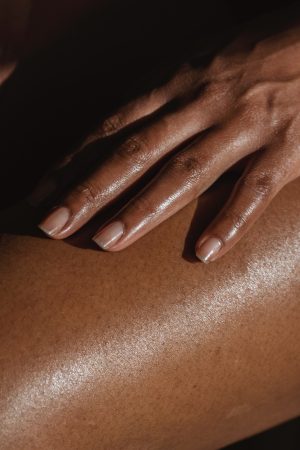
- Nail plate: This is the visible, hard part of the nail.
- Cuticle: The thin layer of skin at the base of the nail that protects the nail matrix.
- Nail matrix: The tissue beneath the cuticle that produces new nail cells.
- Lunula: The half-moon-shaped white area at the base of the nail.
- Nail bed: The skin beneath the nail plate.
Here’s what your nails say about your body’s health
Paying attention to the appearance of your natural nails can reveal or reflect certain aspects of your body’s health – from deficiencies to skin conditions.
Colour changes
Healthy nails are typically pink with a white lunula. Pale or white nails may indicate anemia or liver problems, while yellow nails can be a sign of fungal infections or psoriasis. Bluish nails may point to respiratory or circulatory issues.
When nails are a brown-ish colour, or even black lines across the nail, it could indicate a benign mole underneath the nail or pigmentation.
Brittle or weak nails
Nails that frequently split, break, or peel may be indicative of nutritional deficiencies, particularly in vitamins like biotin, calcium, and iron. Maintaining a balanced diet rich in these nutrients can help improve nail strength.

Pexels
Ridged nails
Vertical ridges on the nails are a common sign of ageing. However, horizontal ridges may suggest more serious conditions like psoriasis, eczema, or nutritional deficiencies.
Pitting
Tiny dents or depressions in the nail’s surface that appear from no reason but can be a sign of psoriasis, eczema, or alopecia areata, an autoimmune disorder.
Beau lines
Dents are a bit deeper than pitting. They are actual lines or grooves that run horizontally and not vertically on the nail. Beau lines usually appear from deep stress and is often associated with a high fever.
Spoon-shaped nails
If your nails curve upward and take on a concave shape, it may indicate iron-deficiency anemia or hemochromatosis, a condition where the body absorbs too much iron. Also often referred to as koilonychia
Clubbing
Clubbed nails are characterised by the rounding and thickening of the fingertips. This can be a sign of various underlying conditions, including lung or heart disease.
White spots
Contrary to popular belief, white spots on the nails are not always a sign of calcium deficiency. More often, they result from minor trauma to the nail matrix.
Changes in lunula
A disappearing lunula may indicate a potential issue with your circulatory system, while a reddish lunula could suggest a heart problem.
Compiled by
Also see: Top 5 trendy nail colours for spring




